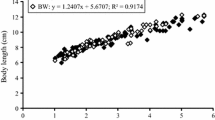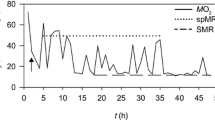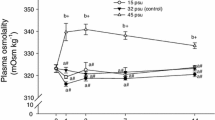Abstract
Survival, osmoregulatory pattern, oxygen consumption, energy spent on metabolism, ammonia excretion, type of oxidized energy substrate, and hepatosomatic index were evaluated in decapods (an osmoregulating crab, Callinectes danae, and an osmoconforming seabob shrimp, Xiphopenaeus kroyeri) exposed to carbon dioxide-induced water acidification (pH 7.3, control pH 8.0) and different salinities (20, 25, 30, 35, and 40‰) for 3 days. Compared to the animals kept at controlled pH, exposure to reduced pH resulted in the loss of osmoregulatory capacity in C. danae at all salinities, except for some hyporegulation at 40‰, and reduced oxygen consumption and ammonia excretion at 20 and 40‰. Xiphopenaeus kroyeri remained an osmoconformer in all evaluated conditions, except for some hyporegulation at 40‰, and when exposed to the reduced pH, it presented changes in oxygen consumption at all salinities and reductions in ammonia excretion at 20 and 35‰ compared to the control animals. Both species use protein as the main energy substrate and decrease the hepatosomatic index when exposed to reduced pH relative to the control. The observed changes may be associated with changes in the activity of enzymes related to osmoregulation, the use of amino acids as osmotic effectors of cell volume control and recovery, and the Bohr effect, and, because the gills are multifunctional organs related to osmoregulation, the changes may be related to acid–base control, nitrogen excretion, and respiration, with a change in one of these functions bringing about changes in the others.



Similar content being viewed by others
References
Almeida AC, Baeza JA, Fransozo V, Castilho AL, Fransozo A (2012) Reproductive biology and recruitment of Xiphopenaeus kroyeri in a marine protected area in the Western Atlantic: implications for resource management. Aquat Biol 17:57–69. https://doi.org/10.3354/ab00462
Arnold KE, Findlay HS, Spicer JI, Daniels CL, Boothroyd D (2009) Effect of CO2-related acidification on aspects of the larval development of the European lobster, Homarus gammarus (L.). Biogeosci Discuss 6:3087–3107. https://doi.org/10.5194/bgd-6-3087-2009
Augusto A, Masui DC (2014) Sex and reproductive stage differences in the growth, metabolism, feed, fecal production, excretion and energy budget of the Amazon River prawn (Macrobrachium amazonicum). Mar Freshw Behav Physiol 47:373–388. https://doi.org/10.1080/10236244.2014.942547
Augusto A, Valenti WC (2016) Are there any physiological differences between the male morphotypes of the freshwater shrimp Macrobrachium amazonicum (Heller, 1862) (Caridea: Palaemonidae)? J Crustac Biol 36:716–723. https://doi.org/10.1163/1937240X-00002467
Augusto A, Greene LJ, Laure HJ, McNamara JC (2007) The ontogeny of isosmotic intracellular regulation in the diadromous, freshwater palaemonid shrimps, Macrobrachium amazonicum and M. olfersi (Decapoda). J Crustac Biol 27:626–634. https://doi.org/10.1651/S-2796
Augusto A, Pinheiro AS, Greene LJ, Laure HJ, McNamara JC (2009) Evolutionary transition to freshwater by ancestral marine palaemonids: evidence from osmoregulation in a tide pool shrimp. Aquat Biol 7:113–122. https://doi.org/10.3354/ab00183
Ávila-da-Silva O, Carneiro MH, Mendonça JT, Servo GDM, Bastos GCC, Okubo-da-Silva S, Sakamoto MS (2007) Produção pesqueira marinha do estado de São Paulo no ano de 2005. Sério de Relatórios Técnicos SP 26:1–44 (ISSN 1678-2283)
Blanchard A, Eladari D, Leviel F, Tsimaratos M, Paillard M, Podevin RA (1998) NH4 + as a substrate for apical and basolateral Na+-H+ exchangers of thick ascending limbs of rat kidney: evidence from isolated membranes. J Physiol 506:689–698. https://doi.org/10.1111/j.1469-7793.1998.689bv.x
Caldeira K, Wickett ME (2003) Oceanography: anthropogenic carbon and ocean pH. Nature 425:365–365. https://doi.org/10.1038/425365a
Cameron JN, Iwama GK (1987) Compensation of progressive hypercapnia in channel catfish and blue crabs. J Exp Biol 197:183–197
Castille JrFL, Lawrence AL (1981) The effect of salinity on the osmotic, sodium and chloride concentrations in the hemolymph of euryhaline shrimp of the genus Penaeus. Comp Biochem Physiol A Mol Integr Physiol 68(1):75–80
Cieluch U, Charmantier G, Grousset E, Charmantier-Daures M, Anger K (2005) Osmoregulation, immunolocalization of Na+/K+-ATPase, and ultrastructure of branchial epithelia in the developing brown shrimp, Crangon crangon (Decapoda, Caridea). Physiol Biochem Zool 78(6):1017–1025
Costa RC, Fransozo A, Melo GAS, Freire FADM. (2003) An illustrated key for dendrobranchiata shrimps from the northern coast of São Paulo state, Brazil. Biota Neotrop 3:1–12 (BN01503012003)
Costa RC, Fransozo A, Freire FAM, Castilho AL (2007) Abundance and ecological distribution of the “Sete-Barbas” shrimp Xiphopenaeus kroyeri (Heller, 1862) (Decapoda: Penaeoidea) in three bays of the Ubatuba Region, Southeastern Brazil. Gulf Caribb Res 19:33–41. https://doi.org/10.18785/gcr.1901.04
Curtis DL, van Breukelen F, McGaw IJ (2013) Extracellular digestion during hyposaline exposure in the Dungeness crab, Cancer magister, and the blue crab, Callinectes sapidus. Comp Biochem Physiol A Mol Integr Physiol 166:564–570. https://doi.org/10.1016/j.cbpa.2013.09.003
Diaz F, Re AD, Sierra E, Diaz-Iglesias E (2004) Effects of temperature and salinity fluctuation on the oxygen consumption, ammonium excretion and osmoregulation of the blue shrimp Litopenaeus stylirostris (Stimpson). J Shellfish Res 23(3):903–910
Dissanayake A, Ishimatsu A (2011) Synergistic effects of elevated CO2 and temperature on the metabolic scope and activity in a shallow-water coastal decapod (Metapenaeus joyneri; Crustacea: Penaeidae). ICES J Mar Sci 68:1147–1154. https://doi.org/10.1093/icesjms/fsq188
Dissanayake A, Clough R, Spicer JI, Jones MB (2010) Effects of hypercapnia on acid–base balance and osmo-/iono-regulation in prawns (Decapoda: Palaemonidae). Aquat Biol 11:27–36. https://doi.org/10.3354/ab00285
Evans DH (2005) The multifunctional fish gill: dominant site of gas exchange, osmoregulation, acid-base regulation, and excretion of nitrogenous waste. Physiol Rev 85:97–177. https://doi.org/10.1152/physrev.00050.2003
Fehsenfeld S, Weihrauch D (2016) Mechanisms of acid – base regulation in seawater-acclimated green crabs (Carcinus maenas). Can J Zool 107:95–107. https://doi.org/10.1139/cjz-2015-0132
Findlay HS, Kendall MA, Spicer JI, Widdicombe S (2010) Relative influences of ocean acidification and temperature on intertidal barnacle post-larvae at the northern edge of their geographic distribution. Estuar Coast Shelf Sci 86:675–682. https://doi.org/10.1016/j.ecss.2009.11.036
Fransozo ML, Nakagaki J (1998) Population biology of Xiphopenaeus kroyeri (Heller 1862) (Decapoda: Penaeidae) from Ubatuba Bay, Sao Paulo Brazil. J Shellfish Res 17:931–935
Freire CA, Cavassin F, Rodrigues EN, Torres AH, McNamara JC (2003) Adaptive patterns of osmotic and ionic regulation, and the invasion of fresh water by the palaemonid shrimps. Comp Biochem Physiol A Mol Integr Physiol 136:771–778. https://doi.org/10.1016/j.cbpb.2003.08.007
Freire CA, Onken H, McNamara JC (2008) A structure–function analysis of ion transport in crustacean gills and excretory organs. Comp Biochem Physiol A Mol Integr Physiol 151:272–304. https://doi.org/10.1016/j.cbpa.2007.05.008
Freire CA, Togni VG, Hermes-Lima M (2011) Responses of free radical metabolism to air exposure or salinity stress, in crabs (Callinectes danae and Callinectes ornatus) with different estuarine distributions. Comp Biochem Physiol A Mol Integr Physiol 160:291–300. https://doi.org/10.1016/j.cbpa.2011.06.024
Gilles R, Delpire E (1997) Variations in salinity, osmolarity, and water availability: vertebrates and invertebrates. In: Dantzler WJI (eds) Handbook of physiology. Section 13: comparative physiology, vol 2, ch 22. Oxford University Press, New York, pp 1523–1585
Goncalves P, Thompson EL, Raftos DA (2017) Contrasting impacts of ocean acidification and warming on the molecular responses of CO2-resilient oysters. BMC Genom. https://doi.org/10.1186/s12864-017-3818-z
Gran G (1952) Determination of the equivalence point in potentiometric titrations. Analyst 77:661–671
Gutowska MA, Melzner F, Langenbuch M et al (2010) Acid-base regulatory ability of the cephalopod (Sepia officinalis) in response to environmental hypercapnia. J Comp Physiol B 180:323–335. https://doi.org/10.1007/s00360-009-0412-y
Hans S, Fehsenfeld S, Treberg JR, Weihrauch D (2014) Acid-base regulation in the Dungeness crab (Metacarcinus magister). Mar Biol 161:1179–1193. https://doi.org/10.1007/s00227-014-2409-7
Heckler GS, Lopes M, Simões SM et al (2014) Annual, seasonal and spatial abundance of the seabob shrimp Xiphopenaeus kroyeri (Decapoda, Penaeidae) off the Southeastern coast of Brazil. An Acad Bras Cienc 86:1337–1346. https://doi.org/10.1590/0001-3765201420130230
Henry RP, Cameron JN (1982) The distribution and partial characterization of carbonic anhydrase in selected aquatic and terrestrial decapod crustaceans. J Exp Zool 221:309–321. https://doi.org/10.1002/jez.1402210306
Henry RP, Lucu C, Onken H, Weihrauch D (2012) Multiple functions of the crustacean gill: osmotic/ionic regulation, acid-base balance, ammonia excretion, and bioaccumulation of toxic metals. Front Physiol 3:1–34. https://doi.org/10.3389/fphys.2012.00431
Heuer RM, Grosell M (2014) Physiological impacts of elevated carbon dioxide and ocean acidification on fish. AJP Regul Integr Comp Physiol 307:R1061–R1084. https://doi.org/10.1152/ajpregu.00064.2014
Jakubowska M, Normant-Saremba M (2016) The influence of carbon dioxide-induced water acidification on the osmotic and metabolic responses of the Baltic amphipod Gammarus oceanicus. Mar Freshw Behav Physiol 49:173–185. https://doi.org/10.1080/10236244.2016.1157928
Knapp JL, Bridges CR, Krohn J, Hoffman LC, Auerswald L (2015) Acid-base balance and changes in haemolymph properties of the South African rock lobsters, Jasus lalandii, a palinurid decapod, during chronic hypercapnia. Biochem Biophys Res Commun 461:475–480. https://doi.org/10.1016/j.bbrc.2015.04.025
Koroleff F (1976) Determination of ammonia. In: Grasshoff K, Ehrhardt M, Krem-Ling K (eds) Methods of seawater analysis, vol 2. Verlag Chemie, Weinhein, pp 150–157
Kurihara H, Matsui M, Furukawa H, Hayashi M, Ishimatsu A (2008) Long-term effects of predicted future seawater CO2 conditions on the survival and growth of the marine shrimp Palaemon pacificus. J Exp Mar Bio Ecol 367:41–46. https://doi.org/10.1016/j.jembe.2008.08.016
Langenbuch M, Pörtner HO (2002) Changes in metabolic rate and N excretion in the marine invertebrate Sipunculus nudus under conditions of environmental hypercapnia: identifying effective acid-base variables. J Exp Biol 205:1153–1160. https://doi.org/10.1016/j.rser.2012.11.069
Lehtonen MP, Burnett LE (2016) Effects of hypoxia and hypercapnic hypoxia on oxygen transport and acid-base status in the Atlantic blue crab, Callinectes sapidus, during exercise. J Exp Zool Part A Ecol Genet Physiol 325:598–609. https://doi.org/10.1002/jez.2054
Lemos D, Phan VN, Alvarez G (2001) Growth, oxygen consumption, ammonia-N excretion, biochemical composition and energy content of Farfantepenaeus paulensis Pérez-Farfante (Crustacea, Decapoda, Penaeidae) early postlarvae in different salinities. J Exp Mar Bio Ecol 261:55–74. https://doi.org/10.1016/S0022-0981(01)00260-X
Leong P, Manahan D (1997) Metabolic importance of Na+/K+-ATPase activity during sea urchin development. J Exp Biol 200:2881–2892
Li E, Wang X, Chen K, Xu C, Qin JG, Chen L (2017) Physiological change and nutritional requirement of Pacific white shrimp Litopenaeus vannamei at low salinity. Rev Aquac 9:57–75. https://doi.org/10.1111/raq.12104
Lignot JH, Spanings-Pierrot C, Charmantier G (2000) Osmoregulatory capacity as a tool in monitoring the physiological condition and the effect of stress in crustaceans. Aquaculture 191:209–245
Longo MV, Díaz AO (2015) Histological and histochemical study of the hepatopancreas of two estuarine crab species, Cyrtograpsus angulatus and Neohelice granulata (Grapsoidea, Varunidae): influence of environmental salinity. Zool Sci 32:163–170. https://doi.org/10.2108/zs140133
Mangum CP, Silverthorn SU, Harris JL, Towle DW, Krall AR (1976) The relationship between blood pH, ammonia excretion and adaptation to low salinity in the blue crab Callinectes sapidus. J Exp Zool Part A Ecol Genet Physiol 195.1:129–136
Masui DC, Furriel RPM, McNamara JC, Mantelatto FLM, Leone FA (2002) Modulation by ammonium ions of gill microsomal (Na+, K+)-ATPase in the swimming crab Callinectes danae: a possible mechanism for regulation of ammonia excretion. Comp Biochem Physiol C Toxicol Pharmacol 132:471–482. https://doi.org/10.1016/S1532-0456(02)00110-2
Masui DC, Furriel RPM, Silva ECC et al (2005) Gill microsomal (Na+, K+)-ATPase from the blue crab Callinectes danae: interactions at cationic sites. Int J Biochem Cell Biol 37:2521–2535. https://doi.org/10.1016/j.biocel.2005.06.004
Mayor DJ, Sommer U, Cook KB, Viant MR (2015) The metabolic response of marine copepods to environmental warming and ocean acidification in the absence of food. Nat Publ Gr. https://doi.org/10.1038/srep13690
Mayzaud P, Conover R (1988) O/N atomic ratio as a tool to describe zooplankton metabolism. Mar Ecol Prog Ser 45:289–302. https://doi.org/10.3354/meps045289
Melo GAS (1996) Manual de identificação dos Brachyura (Caranguejos e siris) do litoral brasileiro. Editora Plêiade/Fundação de Amparo à Pesquisa do Estado de São Paulo. Plêiade/FAPESP, São Paulo, p 604
Oliveira GT, Fernandes FA, Bueno AAP, Bond-Buckup G (2007) Seasonal variations in the intermediate metabolism of Aegla platensis (Crustacea, Aeglidae). Comp Biochem Physiol Part A Mol Integr Physiol 147:600–606. https://doi.org/10.1016/j.cbpa.2006.08.025
Orr JC, Fabry VJ, Aumont O et al (2005) Anthropogenic ocean acidification over the twenty-first century and its impact on calcifying organisms. Nature 437:681–686. https://doi.org/10.1038/nature04095
Paganini AW, Miller NA, Stillman JH (2014) Temperature and acidification variability reduce physiological performance in the intertidal zone porcelain crab Petrolisthes cinctipes. J Exp Biol 217:3974–3980. https://doi.org/10.1242/jeb.109801
Pannevis MC, Houlihan DF (1992) The energetic cost of protein synthesis in isolated hepatocytes of rainbow trout (Oncorhynchus mykiss). J Comp Physiol B 162:393–400
Pequeux A (1995) Osmotic regulation in crustaceans. J Crustac Biol 15(1):1–60
Portner HO, Langenbuch M, Reipschlager A (2004) Biological impact of elevated ocean CO2 concentrations: lessons from animal physiology and earth history. J Oceanogr 60:705–718. https://doi.org/10.1007/s10872-004-5763-0
Rosas C, Cuzon G, Gaxiola G, Priol Y, Pascual C, Rossignyol J, Contreras F, Sanchez A, Wormhouldt AV (2001) Metabolism and growth of juveniles of Litopenaeus vannamei: effect of salinity and dietary carbohydrate levels. J Exp Mar Bio Ecol 259:1–22. https://doi.org/10.1016/S0022-0981(01)00222-2
Sang HM, Fotedar R (2004) Growth, survival, haemolymph osmolality and organosomatic indices of the western king prawn (Penaeus latisulcatus Kishinouye, 1896) reared at different salinities. Aquaculture 234:601–614. https://doi.org/10.1016/j.aquaculture.2004.01.008
Severino-Rodrigues E, Pita JB, Graça-Lopes R (2001) Pesca artesanal de siris (crustacea, decapoda, portunidae) na região estuarina de Santos e São Vicente (SP), Brasil. Bol do Inst Pesca 27:7–19
Shinji J, Okutsu T, Jayasankar V et al (2012) Metabolism of amino acids during hyposmotic adaptation in the whiteleg shrimp, Litopenaeus vannamei. Amino Acids 43:1945–1954. https://doi.org/10.1007/s00726-012-1266-2
Skinner DM (1962) The structure and metabolism of a crustacean integumentary tissue during a molt cycle. Biol Bull 123(3):635–647
Skinner DM (1985) Interacting factors in the control of the crustacean molt cycle. Am Zool 25(1):275–284
Smith DM, Dall W (1985) Staging the tiger prawn, Penaeus esculentus Haswell. In: Rothlisberg PC, Jill BJ, Staples DJ (eds) Second Australian national prawn seminar proc. NPS2, pp 85–93
Whiteley N (2011) Physiological and ecological responses of crustaceans to ocean acidification. Mar Ecol Prog Ser 430:257–271. https://doi.org/10.3354/meps09185
Whiteley M, Lee KM, Greenberg EP (1999) Identification of genes controlled by quorum sensing in Pseudomonas aeruginosa. Proc Natl Acad Sci 96:13904–13909. https://doi.org/10.1073/pnas.96.24.13904
Whiteley NM, Scott JL, Breeze SJ, McCann L (2001) Effects of water salinity on acid-base balance in decapod crustaceans. J Exp Biol 204:1003–1011
Acknowledgements
We thank the coordinator Dr. John Campbell McNamara, Laboratory of the Crustacean Physiology, FFCLRP/USP, Brazil, for all the support offered during the measurements of hemolymph osmolality. Alessandra Augusto received grants from Fundação de Amparo a Pesquisa do Estado de São Paulo (FAPESP -Process 2014/16983-6) and Andressa Cristina Ramaglia da Mota received scholarship from FAPESP (Process 2013/26815-0).
Author information
Authors and Affiliations
Corresponding author
Additional information
Communicated by G. Heldmaier.
Rights and permissions
About this article
Cite this article
Ramaglia, A.C., de Castro, L.M. & Augusto, A. Effects of ocean acidification and salinity variations on the physiology of osmoregulating and osmoconforming crustaceans. J Comp Physiol B 188, 729–738 (2018). https://doi.org/10.1007/s00360-018-1167-0
Received:
Revised:
Accepted:
Published:
Issue Date:
DOI: https://doi.org/10.1007/s00360-018-1167-0




